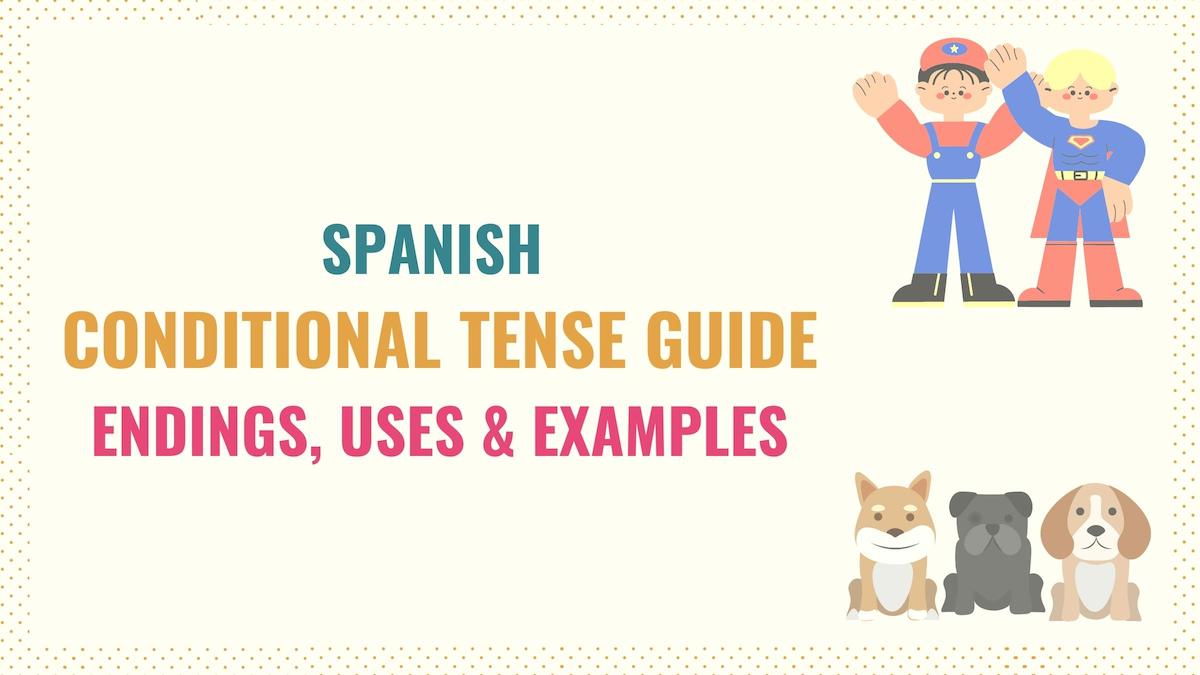The Spanish conditional allows you to make polite requests and expresses that an action depends on fulfilling specific circumstances, among other things. In short, it can help you communicate your ideas more efficiently. With that in mind, in this conditional tense Spanish guide, we’ll learn:
- How to Form the Conditional in Spanish
- Common Uses of the Conditional Tense
- Difference Between Future & Conditional
- Key Points
- What to Do Next
I’ve included real-life applications and examples to help you contextualize this Spanish tense.
How to Conjugate the Spanish Conditional
In the conditional tense, regular verbs are conjugated by adding the conditional endings to the infinitive form.
This tense has one set of endings that work for all regular and irregular -ar, -er, and -ir verbs. In Spanish, the conditional endings are:
| Person | Conditional |
|---|---|
| Yo | -ía |
| Tú | -ías |
| Él / Ella Usted | -ía |
| Nosotros | -íamos |
| Vosotros | -íais |
| Ellos / Ellas Ustedes | -ían |
So, a conjugated verb in the conditional tense would look like:
- Yo daría – I would give
- Tú darías – You would give
- Él daría – He would give
- Nosotros daríamos – We would give
- Vosotros daríais – You would give
- Ellos / Ustedes darían – You / They would give
Take Note: Notice how in English, we use the word “would” to form the conditional. You can use this as a simple cue to know when to use the conditional tense in Spanish.
Because you use the same endings and work with the infinitive form rather than the root, the conditional is one of the most straightforward verbs to conjugate in Spanish.
Notice that yo, él, ella and usted have identical endings. If the context is not enough to determine who we’re talking about, you need to add this information by using the person’s name or corresponding subject pronoun.
Take Note: The endings used to form the Spanish conditional are the same as we use to conjugate -ir and -er verbs in the imperfect tense. However, these tenses aren’t easily confused since the ending is attached to the infinitive for the conditional (bebería), while it’s attached to the root for the imperfect (bebía).
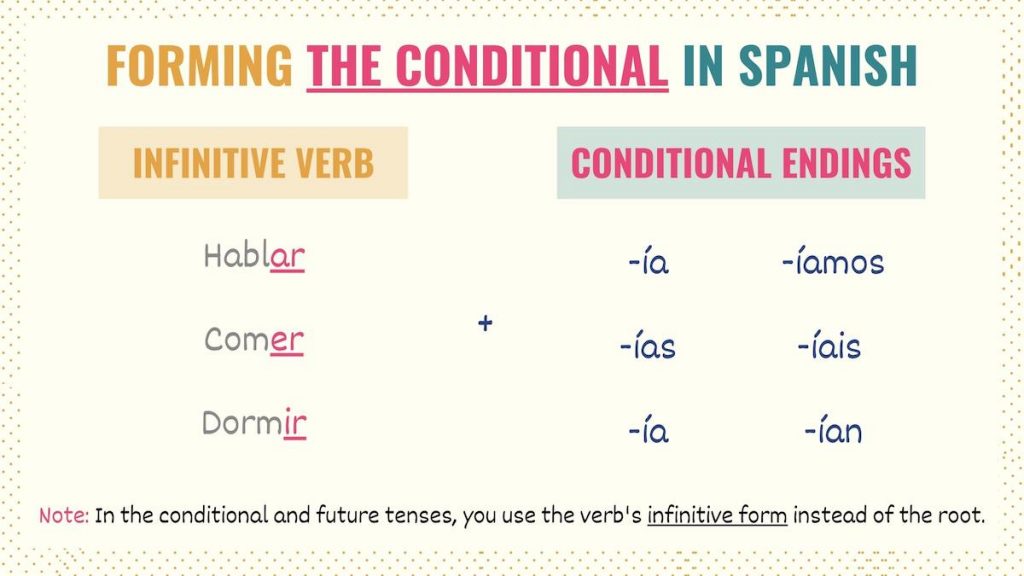
Irregular conditional verbs
In the Spanish conditional tense, irregular verbs are verbs with significant changes in their stem. To conjugate them, you must add the conditional endings to the irregular root.
The irregular conditional verbs in Spanish are:
- Caber: Cabr-
- Decir: Dir-
- Haber: Habr-
- Hacer: Har-
- Poder: Podr-
- Poner: Pondr-
- Querer: Querr-
- Saber: Sabr-
- Salir: Saldr
- Tener: Tendr-
- Valer: Valdr-
- Venir: Vendr-
If you pay attention to this list, you’ll notice a pattern between these verbs. They all add the letter r to the stem. In some cases, we also add d before ‘r’ for spelling and pronunciation reasons.
Here are some sentences using irregular conditional verbs:
No sé qué haríamos sin ti.
I don’t know what we would do without you.
Señorita, ¿nos podría traer más agua?
Miss, could you bring us more water?
Tendrías más dinero si ahorraras más.
You would have more money if you saved more.
Take Note: Irregular verbs in the conditional are also irregular in the Spanish future simple tense.
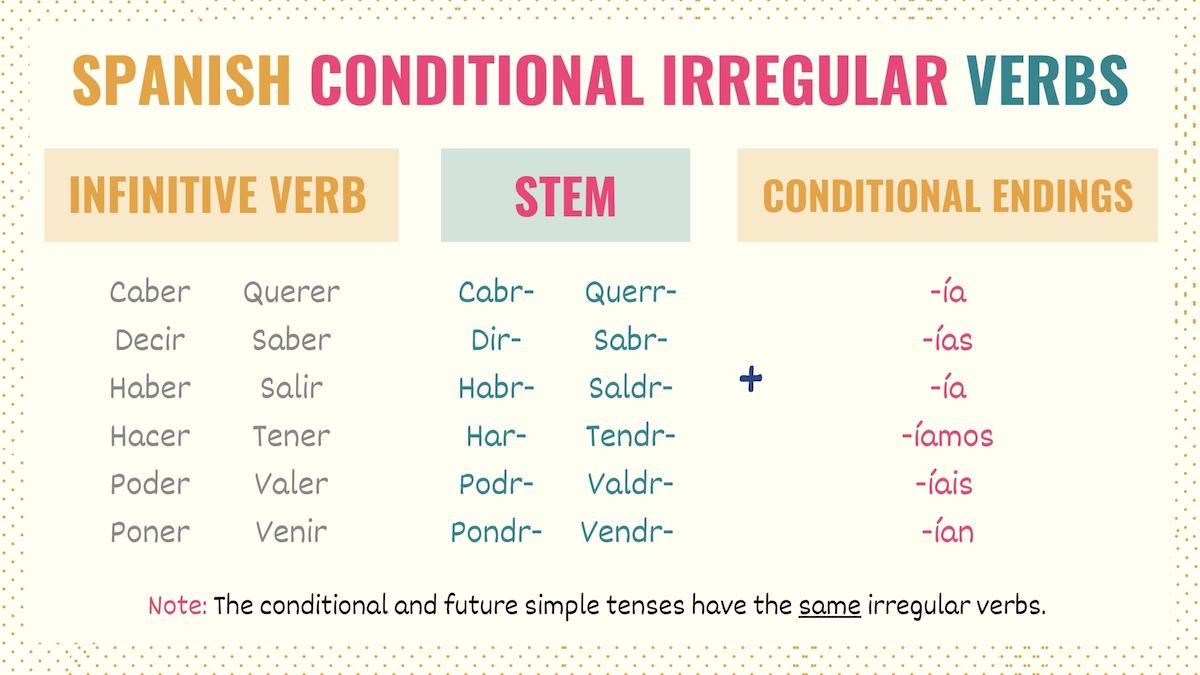
How & When to Use the Spanish Conditional Tense
The conditional simple in Spanish is used:
- To express politeness
- To express conditions and hypothetical situations
- To make conjectures about the past
In the sections below, we’ll explore each one of these applications.
Expressing politeness
The Spanish conditional is often used to request, ask, or suggest something politely. For example:
¿Nos darías unos minutos más?
Would you give us a few more minutes?
¿Me podría decir dónde están los baños?
Could you tell me where the bathroom is?
Yo hablaría con Carlos antes de ir con el director.
I would talk to Carlos before going with the CEO.
In this context, sentences with the conditional convey politeness because your statements are more formal and not perceived as too straightforward. If you’re among friends, you can use the present tense or imperative to ask or request.
Take Note: With this application, the verb poder is commonly used to request something from someone.
Talking about conditions and hypothetical situations
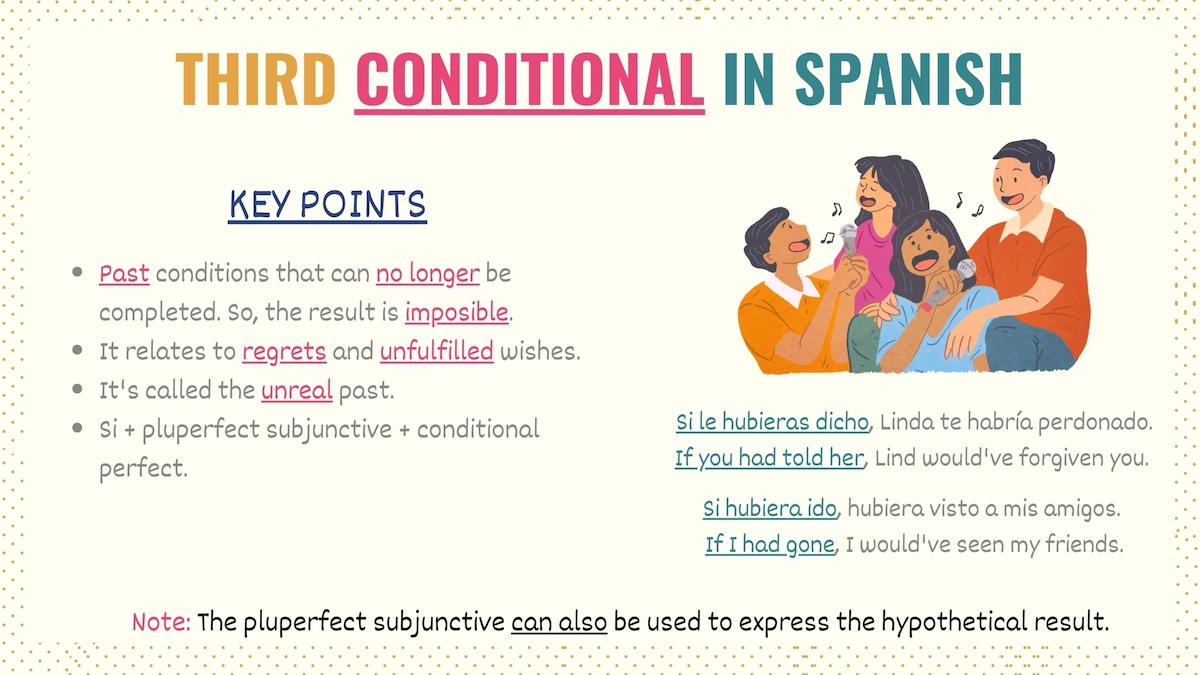
As its name suggests, this tense expresses conditional statements. In other words, it’s used to communicate the imaginary results that would happen if a particular circumstance is met. So, in short, the Spanish conditional refers to hypothetical situations.
When creating sentences with this tense, the conditions can be explicit:
Si + [imperfect subjunctive] + [conditional]
Si quisieras, podrías arreglar mi computadora.
If you wanted, you could fix my computer.
Si los dejaran, ellos traerían sus perros a la oficina.
If they were allowed, they would bring their dogs to the office.
Or implicit:
[Conditional] + pero + [present tense]
La invitaría, pero sé que no va a venir.
I would invite her, but I know she won’t come.
Yo ayudaría a Cindy, pero es muy orgullosa.
I would help Cindy, but she’s so proud.
When it comes to hypothetical situations, the conditional in Spanish can also express wishes that are unlikely to happen:
Daría todo por verte de nuevo.
I would give everything to see you again.
Nos gustaría ir a París el próximo año.
We would like to go to Paris next year.
Take Note: Si clauses are closely related to the conditional since they allow you to introduce imagined circumstances. There are different types of si clauses depending on how achievable or realistic a condition is.
Making conjectures about the past
A more advanced application of the conditional is to speculate about the past. For instance:
Creí que me llamarías ayer.
I thought you would call me yesterday.
¿Y mi paquete? Ya tendría que haber llegado.
And my package? It should have arrived by now.
Just as in English, in Spanish, this use implies more formality. Change the verbs to the appropriate past indicative tense if you don’t want to sound too formal.
On this note about the past, this tense is also used to form the Spanish indirect speech. Simply put, the conditional allows you to repeat what people said they would do in the future. For example:
Max nos dijo que él compraría el pastel.
Max told us that he would buy the cake.
Les dije que llegaría un poco tarde.
I told you guys that I would arrive a bit late.
Take sentence #2 as an example. This statement implies that at some point, I told you “Voy a llegar tarde” (I’ll be late). Because that moment is over, the conditional allows me to reiterate what I said.
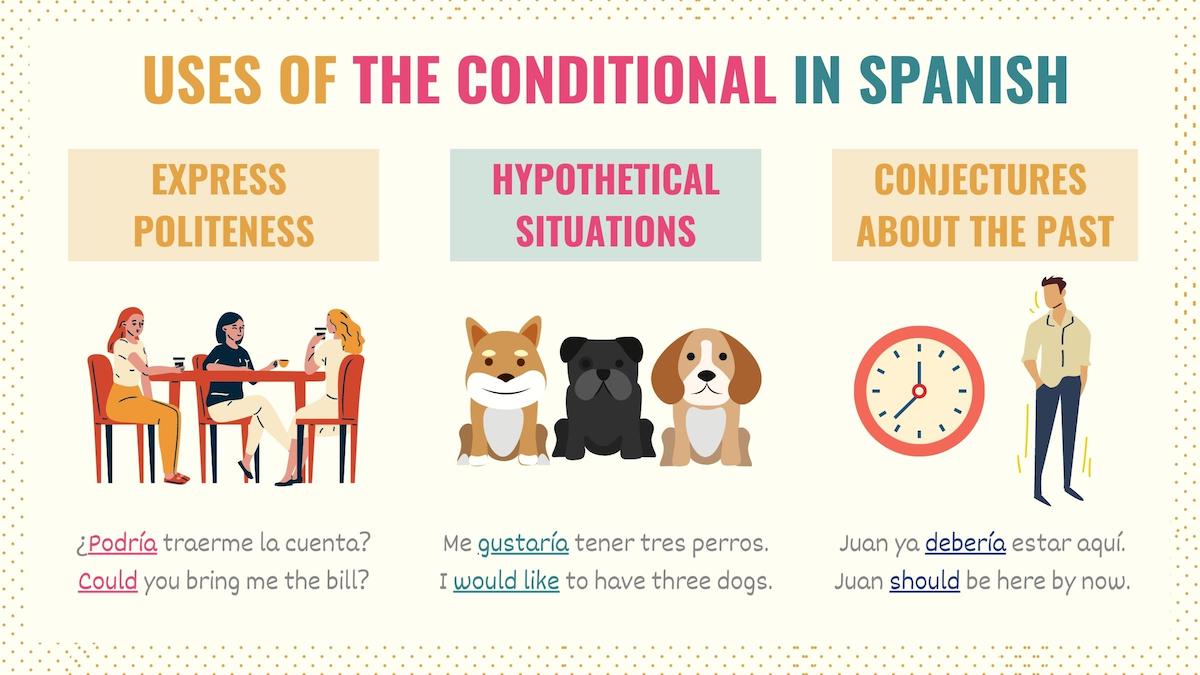
Future vs Conditional in Spanish
In Spanish, the future and conditional refer to events that have not yet happened. However, there are some distinctive differences between these tenses.
The future tense in Spanish expresses that an action or event will happen at some point in the future. For example:
Mañana, iremos al cine.
We will go to the movies tomorrow.
Si puedo, llevaré a mi mamá a un concierto.
If I can, I will take Mom to a concert.
The Spanish conditional, on the other hand, refers to actions that depend on a condition. So, it describes hypothetical or imaginary situations.
Iría al cine, pero tengo mucho trabajo.
I would go to the movies, but I have a lot of work.
Si pudiera, llevaría a mi mamá a un concierto.
If I could, I would take Mom to a concert.
Key Points
Due to its applications, the conditional is key for having effective communication in Spanish. Here are some key points you should keep in mind:
- The same conjugation endings are used for all regular and irregular verbs.
- These endings are ía, ías, ía, íamos, íais, ían.
- Regular conditional verbs are conjugated by adding the conditional ending to the verb’s root.
- Irregular conditional verbs have a stem different from their infinitive form.
- This tense expresses conditions, politeness, hypothetical situations, and conjectures.
- It’s also used to form indirect speech in Spanish.
Now that you’ve learned how to form this tense, you should take the time to practice it and incorporate it into your everyday life.
Conditional Tense Spanish Additional Resources
To fully understand the Spanish conditional, I encourage you to learn more about how si clauses work. In this guide, we covered the conditional simple. But, like many other tenses, it has a compound form. So, make sure you understand how the conditional perfect works.
While there are many tenses in Spanish, there are only 14 that you need to know to become fluent. Check out the 14 must-know Spanish tenses here to discover which to learn next!
Download the Spanish Conditional Tense PDF
The conditional tense is critical to learn for your conversational fluency in Spanish. While we’ve just covered the essentials of this tense, you might need a refresher later. I’ve created a PDF you can download for free with all the key points and graphics from this guide so you can study the conditional tense and revisit this guide.

